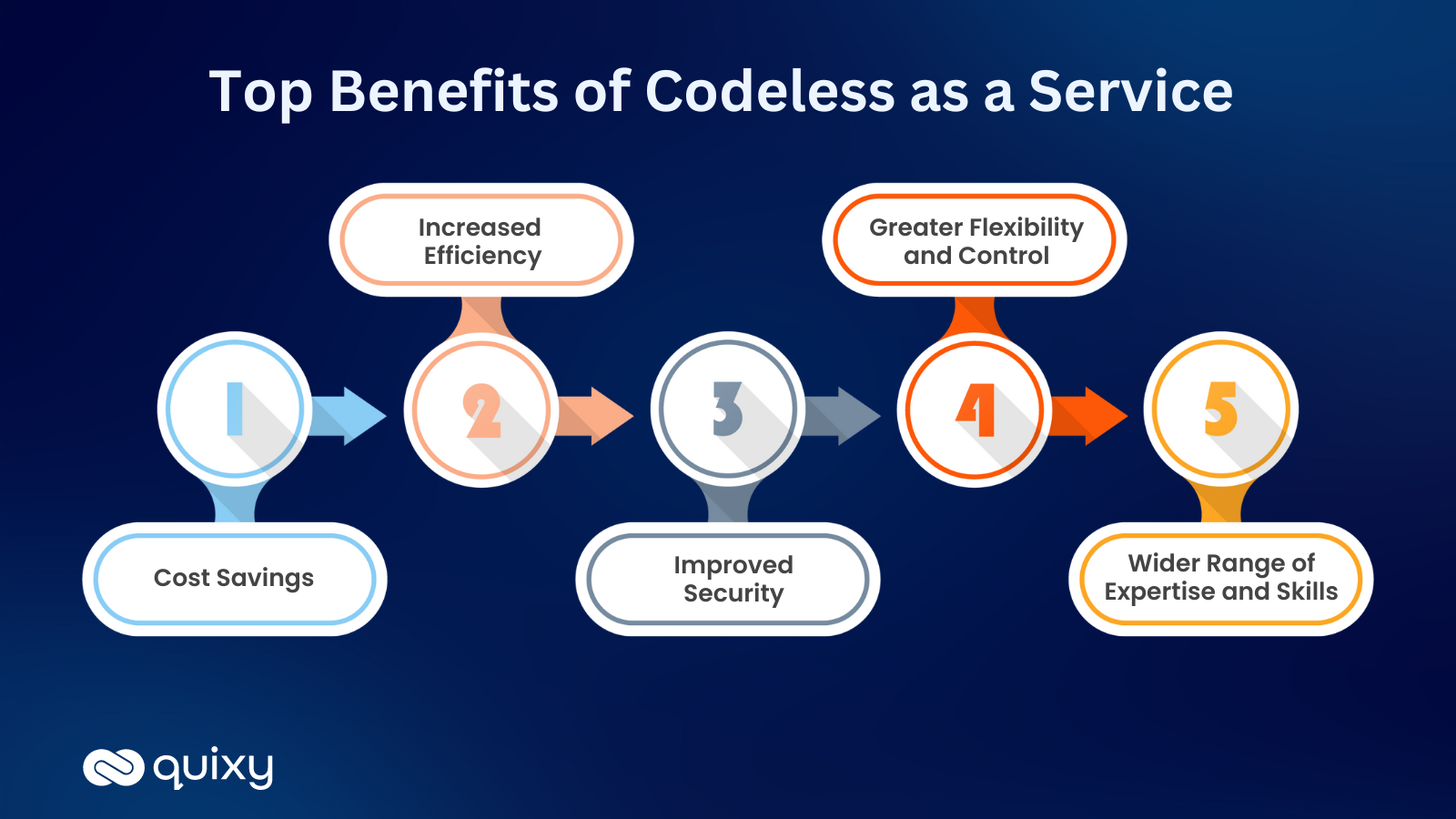
Before we get into Codeless as a Service, we must know the importance of no-code technology for organizations. Let’s go!
The Importance of No-Code Technology
No-code technology has been gaining traction recently and has become increasingly important for organizations of all sizes and industries. The term “no-code” refers to software development platforms that allow users to build applications and software solutions without writing code. Individuals with little to no technical background can create custom software that fits their needs.
The importance of no-code technology lies in its ability to streamline the software development process, making it faster and more efficient. This is especially important for organizations that need to develop custom software solutions quickly but don’t have in-house technical expertise. With no-code platforms, development teams can create software solutions in hours or days instead of weeks or months. This not only saves time but also reduces costs associated with software development.
Another advantage of no-code technology is that it allows organizations to be more agile and quickly respond to changing business needs. Traditional software development can take months to change an existing software solution. But with no-code platforms, updates can be made immediately without waiting for the development team. This allows organizations to keep pace with the changing market and stay ahead of the competition.
No-code technology makes it easier for organizations to scale their software development efforts. As the demand for custom software solutions grows, development teams can quickly and easily build additional applications and software solutions without bringing in additional developers. This saves time and reduces the costs associated with hiring and training new developers.
No-code technology also benefits organizations that want to promote collaboration between technical and non-technical teams. With no-code platforms, non-technical team members can get involved in the software development process, providing valuable input and feedback on how the software should be built and what features are important to them. This collaboration leads to better software solutions tailored to the organisation’s and its users’ specific needs.
Also Read: The Future of Software is No-Code and Low-Code Programming
What is Codeless as a Service?
Codeless as a service refers to a tool or platform enabling users to build applications or workflows without writing code. With Codeless as a service, businesses can quickly and easily build custom software solutions without investing the time and resources required to develop and maintain a development team. Instead, users can use visual interfaces, drag-and-drop functionality, and pre-built templates to create unique business apps.
According to Vodafone, CaaS or Codeless Software are just the commonly used terms used to describe low-code/no-code development platforms which can be used to design and manage software applications without the use of code or script.
The rise of Codeless as a service can be attributed to several factors, including the growing popularity of no-code technology and the need for businesses to be more agile and responsive to changing market conditions. The traditional software development process can be slow and cumbersome, making it difficult for companies to keep pace with the rapidly evolving technology landscape. Codeless-as-a-service solves this problem by allowing business users to build apps without writing any lines of code.
Also Read: Top No-Code Website Builders
Top Benefits of Codeless as a Service
Let’s explore the top 5 benefits of Codeless as a Service and why it represents a significant step forward in the software development industry.

1. Cost Savings
One of the most significant benefits of CaaS (Codeless-as-a-Service) is cost savings. By utilizing internal resources i.e., the subject matter experts as citizen developers, businesses can avoid the costs of hiring and training developers and the costs associated with maintaining and upgrading software development tools and technologies. This can result in significant cost savings for businesses, especially for those who are just starting and do not have the resources to invest in a full-fledged software development team.
2. Increased Efficiency
Codeless as a Service also offers businesses greater efficiency in the development process. With no-code technology, companies can be more involved in the development process and can make changes to software solutions more quickly and easily. This means that businesses can respond to changing market conditions and customer needs more quickly, helping them to remain competitive and relevant in a rapidly changing technological landscape. Additionally, Codeless as a Service providers can help businesses to streamline the development process by using codeless platforms that automate many of the tasks involved in software development, resulting in faster and more efficient software solutions.
3. Improved Security
Another essential benefit of Codeless as a Service has improved security. Many Codeless as a Service providers use no-code platforms, including built-in security features and integrations with popular security tools and frameworks. This reduces the risk of security breaches and helps businesses ensure that their software solutions comply with industry regulations. In an era of increasing cyber threats, improved security is critical for businesses to consider when choosing a software development solution.
4. Greater Flexibility and Control
Codeless as a Service also offers businesses greater flexibility and control over the development process. With no-code technology, businesses can be more involved in the development process and can make changes to software solutions more quickly and easily. This means that businesses can respond to changing market conditions and customer needs more quickly, helping them to remain competitive and relevant in a rapidly changing technological landscape. Additionally, codeless platforms offer businesses greater control over the software development process, allowing them to change software solutions as needed without relying on a software development team.
5. Access to a Wider Range of Expertise and Skills
Finally, Codeless as a Service offers businesses access to broader expertise and skills. With no-code technology, businesses can transfer software development tasks to citizen development experts with specialized skills and experience building no-code custom software solutions. This allows businesses to take advantage of the latest technology and development practices, helping them to remain at the forefront of innovation and technology. Additionally, codeless platforms offer businesses access to a wide range of pre-built templates, modules, and integrations, making building custom software solutions that meet their specific needs easier.
Also Read: How to effectively choose and adopt a No-Code Platform: 10 points to consider!

Key Features of Codeless-as-a-Service
No-code technology provides a range of features that allow users to create, deploy, and manage various applications without writing any code. Some of the key features include:
1. Drag-and-drop interface
No-code platforms usually have a visual, drag-and-drop interface that allows users to build applications by simply dragging and dropping elements onto a canvas.
2. Pre-built templates
Many no-code platforms come with a range of pre-built templates that users can use to build applications for specific use cases quickly.
3. Customization options
While templates provide a quick starting point, users can customize their applications to fit their specific needs by changing colours, fonts, layouts, etc.
4. Integrations
No-code platforms often come with pre-built integrations to popular tools such as CRM systems, payment processors, databases, etc.
5. Cloud hosting
Most no-code platforms offer cloud hosting, allowing users to deploy their applications with just a few clicks.
6. Collaboration
No-code platforms often have collaboration features that allow multiple users to work on an application in real-time.
7. Analytics
Many no-code platforms provide built-in analytics that gives users insights into their applications’ use, including user behaviour, performance metrics, and more.
8. Deployment options
No-code platforms typically offer a range of deployment options, including public-facing web applications, mobile applications, and internal tools.
9. Security
No-code platforms typically have built-in security measures such as user authentication and authorization, data encryption, and more.
Overall, no-code technology aims to make app development accessible to a wider range of people, allowing them to bring their ideas to life without needing to learn to code.
How to Choose the Right CaaS Platform?
When choosing a no-code platform, organizations should consider the following factors:
1. Business requirements
The platform should be able to meet the organization’s specific business requirements, such as data management, workflow automation, and integrations with other systems.
2. User experience
The platform should have an intuitive and user-friendly interface, with drag-and-drop functionality and pre-built templates that make it easy for non-technical users to build and maintain applications.
3. Customization
The platform should allow for customization and personalization to meet the organisation’s unique needs.
4. Integration capabilities
The platform should be able to integrate with other systems, such as databases, cloud services, and third-party applications.
5. Security and compliance
To protect sensitive data, the platform should comply with industry and government regulations and have robust security features, such as encryption and access control.
6. Support and resources
The platform should offer good support and resources, such as documentation, tutorials, and forums, to help users get started and troubleshoot any issues they may encounter.
7. Cost
The platform should offer a cost-effective solution with pricing that is transparent and flexible pricing to meet the organization’s budget and changing needs.
8. Scalability
The platform should be scalable to accommodate growing needs as the organization expands.
By considering these factors, organizations can ensure that they choose a no-code platform that meets their needs and helps them achieve their goals.
Also Read: A Comprehensive Glossary of Digital Transformation Terms
Tips for Adopting No-Code Technology
Here are some tips for organizations who want to adopt no-code technology:
- Begin with a simple project to gain experience with the platform and build confidence in the technology.
- Involve all relevant stakeholders in the adoption process, including IT, business users, and executives, to ensure buy-in and support.
- Clearly define the business goals and objectives the organization wants to achieve with no-code technology, such as automation, increased efficiency, and improved customer experience.
- Select a no-code platform that meets the organization’s specific business requirements and has the capabilities and features needed to support the desired outcomes.
- Provide training and support to users to help them effectively use the no-code platform and build applications that meet their needs.
- Regularly evaluate the effectiveness of the no-code platform and make any necessary adjustments to ensure it continues to meet the organization’s needs.
- Encourage innovation and creativity by providing opportunities for users to experiment with the platform and build new applications.
- Foster a collaborative relationship between the business users and IT to ensure that the technology is aligned with the organization’s overall IT strategy and architecture.
By following these tips, organizations can effectively adopt no-code technology and leverage it to drive business value and achieve their goals.
Also Read: This is why you must use No-Code for IT Operations
The Takeaway
Codeless as a Service is a significant step forward in the software development industry, offering businesses a powerful tool for building custom software solutions tailored to their specific needs. With its ability to reduce costs, increase efficiency, improve security, offer greater flexibility and control, and provide access to a broader range of expertise and skills, CaaS is poised to transform how businesses approach software development. By leveraging no-code technology, businesses can be more involved in the development process and create software solutions tailored to their specific needs without requiring coding expertise. Whether you are a small startup or a large enterprise, Codeless as a Service offers a valuable and cost-effective solution for all your software development needs. Get Started today! Empower your organization with automation and customized app development without coding.
Subscribe
Login
Please login to comment
0 Comments
Oldest















